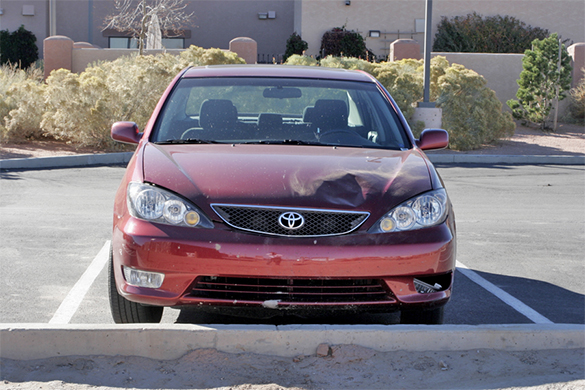I have encountered various unexpected events while photographing the night sky. Some are spectacular, like the flash of a brilliant meteor exploding in the sky and lighting up the landscape. Some are startling: the crash of a tree felled by a nocturnal beaver. Some are annoying: the competitive calling of amorous ducks and their disruption of the mirror lake surface I was trying to photograph. And some are downright dangerous.
I had spent the evening in Monument Valley, Arizona. The weather was clear, cool, but windy, and I had found protection from the wind on the veranda of the Navaho Tribal Park’s visitor center. I again resorted to the tactic of temporarily unscrewing the security floodlights and spent an almost-productive evening taking pictures (the wind, abated from its full flagpole-whipping velocity, was still too high for stable long exposures through a telescope. That didn’t stop me from going through the motions and gaining practice with my equipment).
The pleasant challenges of the evening came to a close as I realized how cold I had become. I packed up and started the drive back to where I was staying, a hotel in Kayenta, twenty miles away.
The drive home after a night’s observing is always more challenging than the outbound drive to your observing site. It is late, or rather, early morning, your blood sugar is at its diurnal lowest, and your usual bedtime was hours ago. If you are like me, you are pumped up from the experience of observing the sky on a clear night. As you prepare for the drive home, running the defroster at full strength to the windshield, you are in an odd mix of mental and physical states.
The roads are empty, and even though you are not looking directly at them, the blast of your headlights onto the pavement ahead obliterates the night vision you had so carefully cultivated and protected throughout the night. The world that you had so easily navigated with nothing more than starlight and a dim red lamp, now closes in to a narrow tunnel of visibility directly in front, and the best you can do is follow the reflective dotted line down the center of the road.
The road I followed was flat and straight and well-paved. Signposts along the way advised me to watch for animals and so I proceeded with vigilance, expecting rabbits or maybe coyotes to be the nocturnal residents of the desert. I successfully made it all the way back to the town and was driving down main street, approaching the final intersection a few blocks from my hotel when I noticed that there were cows grazing along the side of the road. No, they were ON the road, standing in the gutter at the edge, inspecting the sparse blades of grass that somehow grow through pavement cracks and hardpack.
I thought this was odd, since there is fencing everywhere, outlining the large tracts of land needed to sustain cattle and sheep. Wherever the barbwire needs to cross a road, a cattleguard is used; bars of steel, spaced at just the right pitch to make it hard for the cow to cross, its foot slips into the gaps, but still possible for car tires to roll across. Somehow, these cows had ended up on the wrong side of the fence. And they probably couldn’t get back!
I looked to the other side of the road. Cows were milling around there too. I was surrounded. I looked ahead and suddenly realized that I was about to plow directly into one! What?! Huh? I slammed on the brakes but it was too late.
In the moment preceding the collision I had the experience of the world switching to slow motion. I thought that I was about to suffer the fate of drivers from my part of the country that encounter large moose and elk; the animal is gutted as it crashes through the windshield and its butchered parts are delivered into the driver’s lap. Sometimes the driver survives. Even though my mind was racing through this possibility and calculating how I could best prepare for the impact, my body was trapped in the physics of my time-altered world, it couldn’t react.
The car smacked into the broadside of the steer, which then started to skid up the hood toward the windshield. Before reaching me however, the mass and momentum suddenly shifted back, and the cow was delivered unceremoniously onto its other side, flat on the road. The car had stopped, my face was pressed against the windshield and through it I saw the poor animal somehow get back to its feet, and with a stunned look, stagger off to the side of the road.
And I was still alive too. Evidently my speed was low enough, and the cow was soft enough, that the impact was below the g-force thresholds of the airbags. There was no one around. I wondered what I should do. The car was operational, and with the cows watching carefully (one of them with tenderized ribs), I drove at snail’s pace the last few blocks home.



Pingback: Monuments at Night, Nov 4, early | Thor's Life-Notes